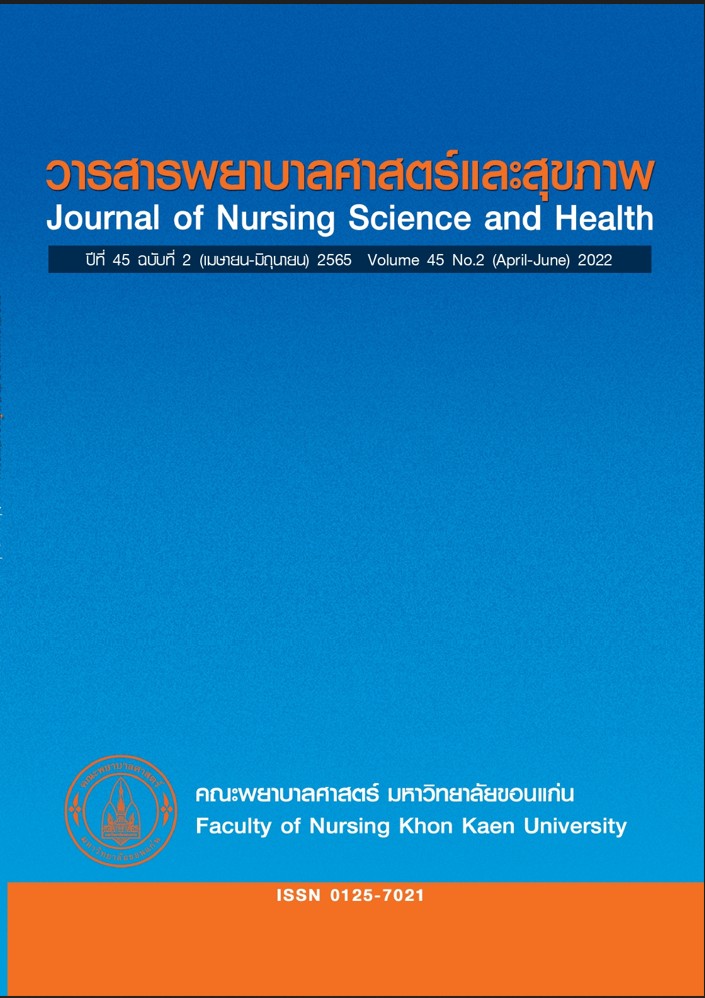การจัดท่านอนคว่ำในผู้ป่วยโควิด 19 เพื่อเพิ่มประสิทธิภาพออกซิเจนในปอด: กรณีไม่ได้ใส่ท่อช่วยหายใจในผู้ใหญ่และผู้สูงอายุ
คำสำคัญ:
ท่านอนคว่ำ, ผู้ป่วยที่ไม่ใส่ท่อช่วยหายใจ, ผู้ป่วยติดเชื้อโควิด-19 , ปอดอักเสบบทคัดย่อ
ทั่วโลกรวมทั้งประเทศไทยต่างได้รับผลกระทบจากการระบาดของเชื้อไวรัสโคโรนา 2019 และเมื่อ
ผู้ป่วยต้องเข้ารับการรักษาในสถานบริการ มีแนวปฏิบัติสำคัญของการรักษาภาวะปอดอักเสบจากเชื้อนี้ซึ่งมัก
ก่อให้เกิดภาวะพร่องออกซิเจนในเลือดเฉียบพลันรวมถึงการเกิดภาวะหายใจล้มเหลวตามมา จากปัญหาการทำงานของเนื้อปอดที่มีความยืดหยุ่นลดลงและส่งผลให้การกำซาบของออกซิเจนลดลงด้วย
ในสถานการณ์ที่มีการระบาดและมีผู้ป่วยจำนวนมากเกินกว่าที่หอผู้ป่วยวิกฤตซึ่งดูแลผู้ป่วยกลุ่มที่ใช้
เครื่องช่วยหายใจจะรองรับได้ ดังนั้นการดูแลผู้ป่วยส่วนหนึ่งที่มีปัญหาทางเดินหายใจระดับปานกลางในหอผู้ป่วยกึ่งวิกฤตโดยไม่ต้องใส่ท่อและใช้เครื่องช่วยหายใจด้วยการจัดท่านอนคว่ำร่วมกับการให้ออกซิเจนในอัตราการไหลสูงจึงนับเป็นวิธีการที่สามารถช่วยการหายใจของผู้ป่วยได้อีกทางหนึ่ง บทความนี้จึงนำ เสนอความรู้ทางการพยาบาลที่เกี่ยวข้องในการจัดท่าเพื่อเพิ่มการกำซาบออกซิเจนและแลกเปลี่ยนก๊าซตลอดจนประสบการณ์การดูแลกรณีตัวอย่างในผู้ป่วยผู้ใหญ่และผู้สูงอายุติดเชื้อโควิด 19 อันจะเป็นประโยชน์แก่ผู้ปฏิบัติงานและผู้สนใจในการประยุกต์ใช้ความรู้ดูแลผู้ป่วยกลุ่มนี้ต่อไป
เอกสารอ้างอิง
Whittle JS, Pavlov I, Sacchetti AD, Atwood C, Rosenberg MS. Respiratory support for adult patients with COVID‐19. JACEP 2020;1(2):95-101.
Tzotzos SJ, Fischer B, Fischer H, Zeitlinger M. Incidence of ARDS and outcomes in hospitalized patients with COVID-19: A global literature survey. Crit Care 2020;24:516.
Liu Q, Wang RS, Qu GQ, Wang Y, Liu P, Zhu Y, et al. Gross examination report of a COVID-19 death autopsy. Fa yi xue za zhi 2020;36(1):21-3.
Ding L, Wang L, Ma W, He H. Efficacy and safety of early prone positioning combined with HFNC or NIV in moderate to severe ARDS: A multi-center prospective cohort study. Crit Care 2020;24(1):1-8.
Johnson NJ, Luks AM, Glenny RW. Gas exchange in the prone posture. Respir Care 2017; 62(8):1097-110.
Scholten EL, Beitler JR, Prisk GK, Malhotra A. Treatment of ARDS with prone positioning. Chest 2017;151(1):215-24.
Gattinoni L, Busana M, Giosa L, Macri MM, Quintel M. Prone positioning in acute respiratory distress syndrome. Semin Respir Crit Care Med 2019;40(1):94–100.
Brochard L, Slutsky A, Pesenti A. Mechanical ventilation to minimize progression of lung injury in acute respiratory failure. Am J Respir Crit Care Med 2017;195(4):438-42.
Carteaux G, Perier F, Maraffi T, Razazi K, De Prost N, Mekontso Dessap A. Patient selfinflicted lung injury: What the intensivist needs to know.Méd.IntensiveRéa2019;28(1):11-20.
Yang X, Yu Y, Xu J, Shu H, Liu H, Wu Y, et al. Clinical course and outcomes of critically ill patients with SARS-CoV-2 pneumonia in Wuhan, China: A single-centered, retrospective, observational study. Lancet Respir Med 2020;8(5):475-81.
Despres C, Brunin Y, Berthier F, Pili-Floury S, Besch G. Prone positioning combined with high-flow nasal or conventional oxygen therapy in severe Covid-19 patients. Crit Care 2020;24(1):256.
Xu Q, Wang T, Qin X, Jie Y, Zha L, Lu W. Early awake prone position combined with high-flow nasal oxygen therapy in severe COVID-19: A case series. Crit Care 2020;24(1):1-3.
Sartini C, Tresoldi M, Scarpellini P, Tettamanti A, Carcò F, Landoni G, et al. Respiratory parameters in patients with COVID-19 after using noninvasive ventilation in the prone position outside the intensive care unit. JAMA 2020;323(22):2338-40.
Elharrar X, Trigui Y, Dols A-M, Touchon F, Martinez S, Prud’homme E, et al. Use of prone positioning in nonintubated patients with COVID-19 and hypoxemic acute respiratory failure. JAMA 020;323(22):2336-8.
Bamford P, Bentley A, Dean J, Whitmore D, Wilson-Baid N. ICS guidance for prone positioning of the conscious COVID patient 2020. United Kingdom: Intensive Care Society; 2020. Available from https://emcrit.org/wp-content/uploads/2020/04/2020-04-12-Guidance-for-conscious-proning.pdf.
Bentley SK, Iavicoli L, Cherkas D, Lane R, Wang E, Atienza M, et al. Guidance andpatient instructions for proning and repositioning of awake, non-intubated COVID-19 patients. Acad Emerg Med 2020;27(8): 787-91.
Bower G, He H. Protocol for awake prone positioning in COVID-19 patients: To do it earlier, easier, and longer. Crit Care 2020;24(1):1-3.
Jiang LG, LeBaron J, Bodnar D, Caputo ND, Chang BP, Chiricolo G, et al. Conscious proning: An introduction of a proning protocol for nonintubated, awake, hypoxic emergency department COVID‐19 patients. Acad Emerg Med 2020;27(7):566-9.
Touchon F, Trigui Y, Prud’ homme E, Lefebvre L, Giraud A, Dols A-M, et al. Awake prone positioning for hypoxaemic respiratory failure: Past, COVID-19 and perspectives. Eur Respir Rev 2021; 30(160):210022.doi: 10.1183/16000617.0022-2021.
Ng Z, Tay WC, Ho CH. Awake prone positioning for non-intubated oxygen dependent COVID-19 pneumonia patients. Eur Respir J 2020;56:2001198.
Coppo A, Bellani G, Winterton D, Di Pierro M, Soria A, Faverio P, et al. Feasibility and physiological effects of prone positioning in non-intubated patients with acute respiratory failure due to COVID-19 (PRON-COVID): A prospective cohort study. Lancet Respir Med 2020;8:765-74.
Oliveira VMd, Weschenfelder ME, Deponti G, Condessa R, Loss SH, Bairros PM, et al. Good practices for prone positioning at the bedside: Constructionof acareprotocol. RevAssoc Med Bras 2016;62:287-93.
Roca O, Caralt B, Messika J, Samper M, Sztrymf B, Hernández G, et al. An index combining respiratory rate and oxygenation to predict outcome of nasal high-flow therapy. Am J Respir Crit Care Med 2019; 199(11):368-76.
ดาวน์โหลด
เผยแพร่แล้ว
รูปแบบการอ้างอิง
ฉบับ
ประเภทบทความ
สัญญาอนุญาต
ลิขสิทธิ์ (c) 2022 วารสารพยาบาลศาสตร์และสุขภาพ

อนุญาตภายใต้เงื่อนไข Creative Commons Attribution-NonCommercial-NoDerivatives 4.0 International License.
วารสารพยาบาลศาสตร์และสุขภาพเป็นเจ้าของลิขสิทธิ์ในการเผยแพร่ผลงานที่ตีพิมพ์ห้ามผู้ใดนำบทความที่ได้รับการตีพิมพ์ในวารสารพยาบาลศาสตร์และสุขภาพไปเผยแพร่ในลักษณะต่าง ๆ ดังนี้ การนำบทความไปเผยแพร่ออนไลน์ การถ่ายเอกสารบทความเพื่อกิจกรรมที่ไม่ใช่การเรียนการสอน การส่งบทความไปตีพิมพ์เผยแพร่ที่อื่น ยกเว้นเสียแต่ได้รับอนุญาตจากวารสารพยาบาลศาสตร์และสุขภาพ



